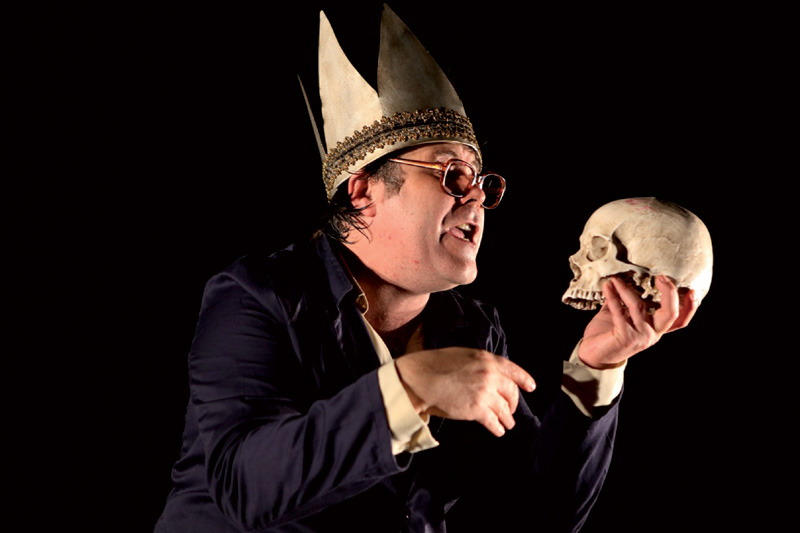The director and theatrical critic of Artez magazine, Carlos Gil, has described as a "milestone" the adaptation of Hamlet to the Basque country. The critic recalls the words of Ramón Labaien, who in the 1980s was the first cultural advisor of the Basque Government when he considered that television in Euskera, the creation of the Symphony Orchestra of the Basque Country and the cult of Hamlet would be a sign of the stability of the Basque Country and the Basque culture.
Xabier Mendiguren has been in charge of writing the adaptation to the Basque, according to which Hamlet is a Basque of the twenty-first century. So he's done a new reading to a character that has thousands of mirrors and meanings. The work, which was left under the direction of Ximun Fuchs, was attended by Ander Lipus, Ainara Gurrutxaga, Manex Fuchs, Maika Etxekopar, Iñaki Ziarrusta, Miren Tirapu and Urko Redondo, among others. The music is by Asier Ituarte and the choreography by Philippe Ducou.
On the other hand, the project has brought together associations and cultural halls of Ipar Euskal Herria such as the Basque Cultural Institute, Hameka, Ote Lore, the gaztetxe of Ttattola Hazparne, the Eiatze House of Culture, the municipalities of Hendaia and Bidar, Biarritz Culture, the popular theatre of Nafta
Enigmatic character
The play Cenizas, of the three groups, was welcomed and was awarded the City of San Sebastian Theatre Award. The same working team has been assembled. “After creating ashes, it was clear that we had to continue working together,” explains Ximun Fuchs, director of the Hamlet play and member of the Le Petit Theatre du Pain group. “It was also clear that we didn’t have to make Ash 2. In mentioning the issues, Hamlet fite was mentioned in the interview.”
A classic, an ancient myth is the Prince of Denmark, a serious theater. It can be considered a milestone for the current Basque theatre, but Fuchs does not agree: “When referring to Hamlet, the words clarity and fluidity have always come. Yes, it's an enigma. Why doesn't Hamlet take action? What is justice, what causes action and thought, fear, words, revenge, destiny? But it is not a milestone, but a succession of what has been done so far. And I hope that many other Hamlets will be proposed in Euskera, and that they will be given as normal.”
Mendiguren has placed the work in the Basque Country and in the twenty-first century. Ambition, revenge, madness, conspiracy ... Does all of this have a place among us? “That’s the question we put, that’s it. There are a thousand theories that have revolved around Hamlet: Hamlet was the first Protestant, Jewish, homosexual, female, communist ... Ours is: Hamlet is a current Basque. Then it is up to the public to appreciate the echoes of the text,” Fuchs said.
Shakespeare wrote the tragedy between the 16th and 17th centuries, in which England lived some culturally glorious years. The original work uses a rich language, as most are characters from the Danish courts. Poetry is very present in the monologues of Hamlet. The adaptation of Xabier Mendiguren has had to cope with this original text overlap. According to Fuchs, “Mendiguren has worked in the form of Shakespeare, that is, with actors. All his proposals have gone through the stage and the language has settled with the actors. He has worked hard to maintain a balance between original poetry and current language.”
However, it has been difficult to keep true to the original text, as Shakespeare’s original play has six parts and is long. “We have had the challenge in the elections, that is, we have not set up a six-hour work, but an hour and a half. The narrative thread on the stage has been reorganized, by action and above all by themes”.
The director has opted for an empty and bright space. “I wanted to leave room for the actors, without any kind of impediment. This creates the need for play, just as children experience it. The theater is not dark, hard from time to time and can be sad, but not dark. I hope that pleasure and joy will emerge from this tragedy. In that we have worked with the actors, guaranteeing pregnancy at all times”.
Poet or crazy?
Ander Lipus is the 21st century Basque Hamlet. The actor finds it difficult to define this play, “but it is true that we respond to certain needs of the Basque theatre, such as the adaptation of the classics”.
The actors have had an adaptation and an original work, they have worked with both. “We are seven actors on stage and each one has different characters to represent,” says Lipus. “However, not all the characters that appear in Shakespeare’s play appear. Compared to the original, I would say that the playwright will be a breaker.”
We asked Lipus how he took on the challenge of facing the monologues of Hamlet and answered: “When you face a text, it’s always a challenge. The goal is to appropriate those words and transmit them to the public afterwards. For me, every work has its importance, its dimension, whether it be Hamlet or Peru Abarka. The key is how you dance with those words of the character, and especially how you transmit them. As our director would say, we came to ask the public questions about what to do in the face of certain violent situations that we live in Euskal Herria.
Throughout history there have been a number of Hamlet. These references have not been taken into account by Lipus: “The experiences we have tattooed on our own skin are the best references, the most real ones.”
Xabier Mendiguren: "Guztiok gara neurri batean Hamlet"
Nola hartu zenuen Hamleten egokitzapena egiteko lana? Nondik hasi zara?
Ez da berez proiektu pertsonal bat izan. Publikoari gorroto obraren lanketan zehar, Fuchs, Lipus eta gainerakoekin lanean jarraitzeko gogoa sortu zen; zenbait bilera izan genituen gero, zer egin erabakitzeko, eta hauxe adostu genuen azkenean.
Posible da Hamlet Euskal Herrian eta XXI mendean kokatzea?
Bai. Zuk diozun bezala, gaur eta hemen, Euskal Herrian eta XXI. mendean, gure arazo guztiekin. Jatorrizko istoriotik zer dagoen eta zer ez jakiteko, ikustera etorri behar.
Hainbat ispilu izan ditu Hamlet pertsonaiak historian barrena. Nolakoa da Hamlet Xabier Mendigurenen begietatik ikusita? Poeta? Eroa? Koldarra?
Alderdi asko dituen pertsonaia da Hamlet, dudarik gabe. Eta, horrez gain, guztiok gara neurri batean Hamlet, edo guztiongan bizi da Hamlet txiki bat. Ikuspegi hori ere azaltzen du obra honek.
Jatorrizko antzezlanean hizkera gortesaua erabiltzen du Shakespearek, korteetako pertsonaiak dira gehienak, hizkuntza kultua erabiltzen dute. Zein baliabide erabili duzu testuan?
Erregistro ezberdinak erabili ditugu: palazioan palaziokoa, eta kalean kalekoa.
Hamlet bezalako antzezlan bati aurre egitea mugarria al da euskal antzerkigintzarako?
“Mugarri” hitz potolo samarra da; gauzak ondo egiten saiatu gara gu, publikoari lan mamitsu bat eskaintzen, estetikaz eta edukiz zer pentsatua emango diona, eta horretan jarraitu nahi genuke aurrerantzean ere, euskal teatroa aberasten.















